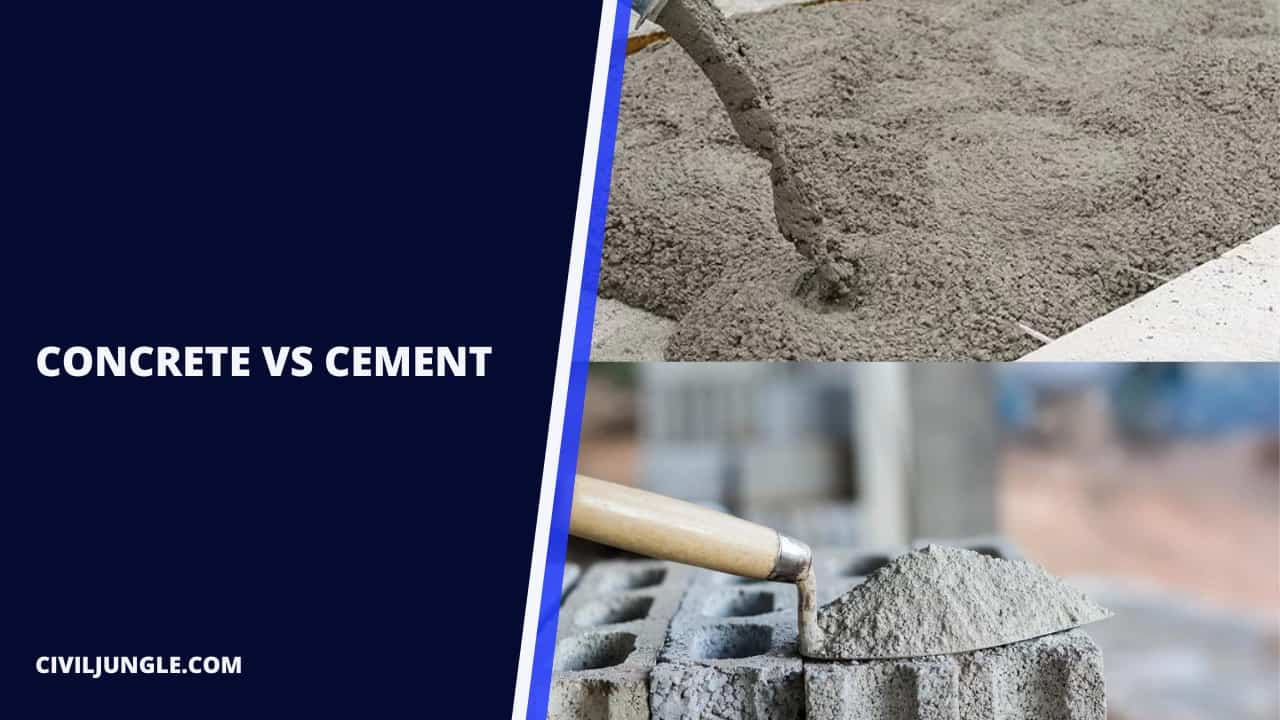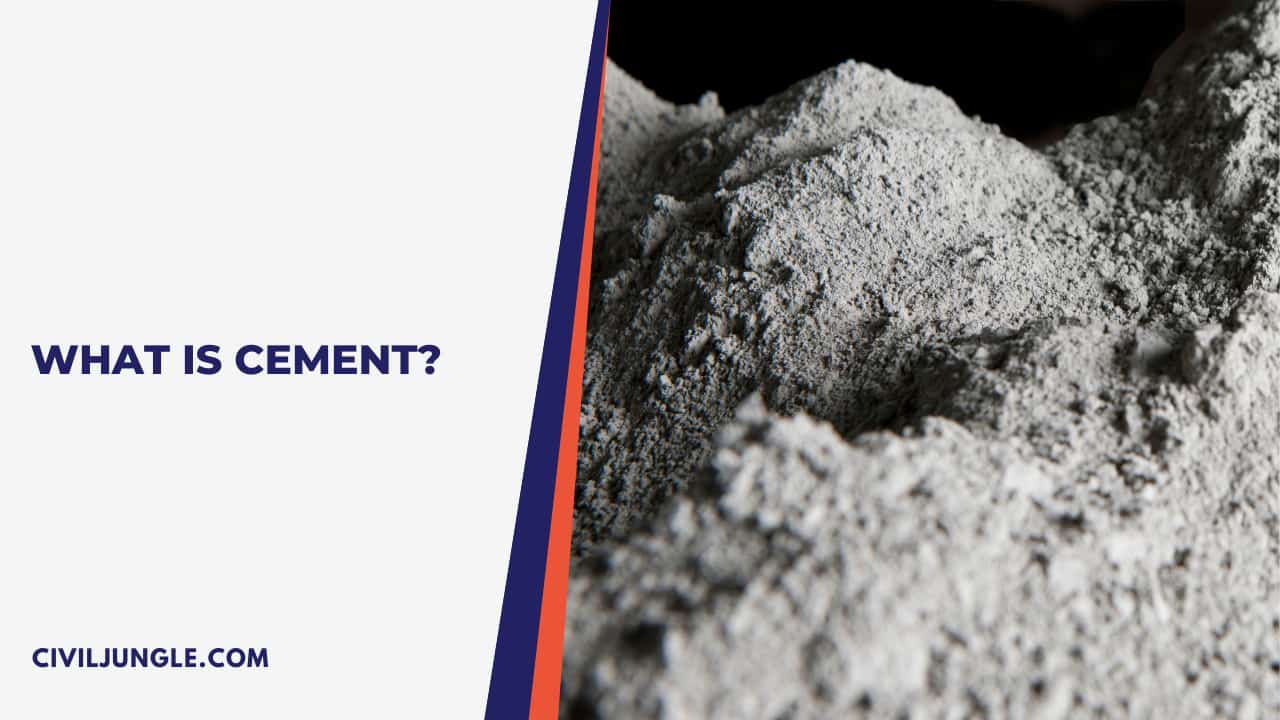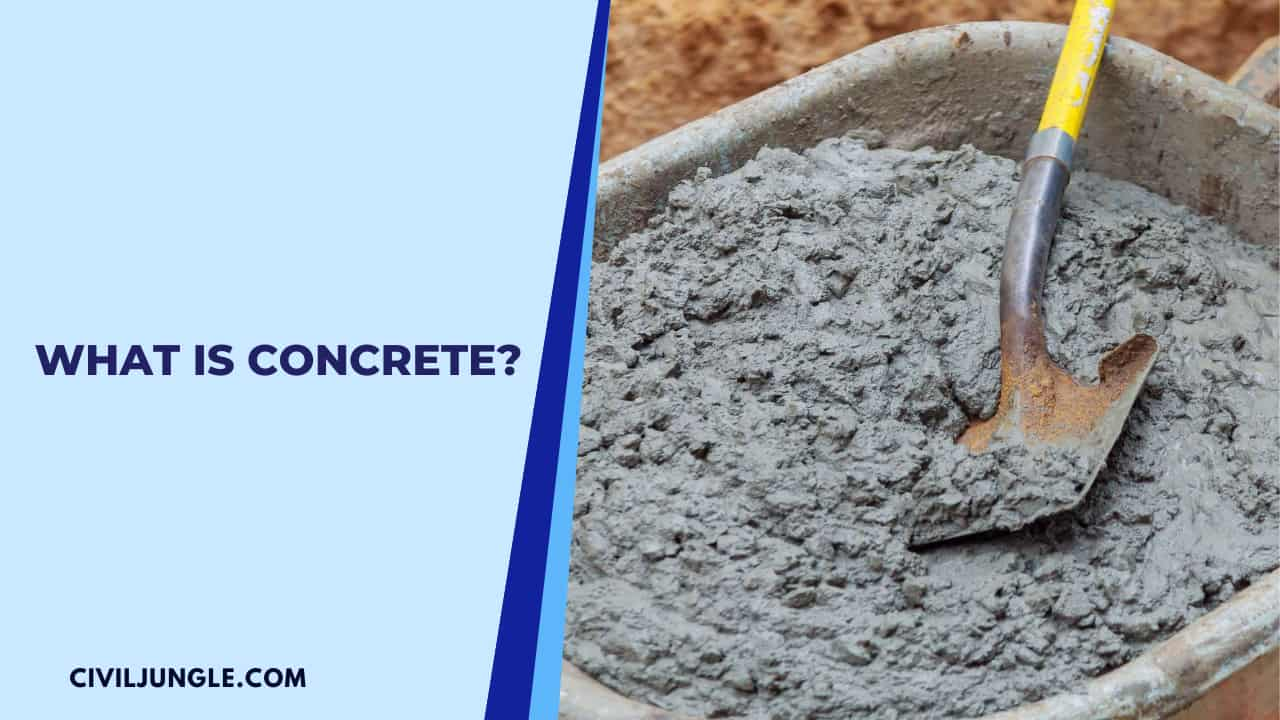Concrete Vs Cement
Important Point
Cement is often confused with concrete, and it is a common misconception that cement and concrete are interchangeable terms.
Knowing the basic fundamentals of each, including history, composition, and differences, will help you gain more knowledge when talking to construction experts.
First things first: cement is an ingredient in concrete. Concrete is the final product used in the construction of foundations, sidewalks, roads, homes and the infrastructure around it.
Below, we will take a closer look at cement and concrete, including the main differences and uses.
Also, read: Cinder Block Vs Concrete Block | What Is Cinder Blocks | What Is Concrete Blocks
What Is Cement?
Cement – which is the “glue” that joins concrete – is a fine powder made from crushed minerals, such as limestone and clay, which act as binders.
Cement can be made from a variety of materials, but it cannot be used alone. In fact, Roman cement was crushed with burnt lime, volcanic ash, and brick supplements.
Today, Portland cement is the most common cement used and is one of the lowest cost materials in the world due to the wide availability of limestone and shale.
Also, read: Difference Between 33, 43 and 53 Grade Cement
There Are Five Types of Portland Cement with the Following Features:
- Type I cement is good for general purposes, where special properties are not required.
- Type II has moderate resistance to sulfate and makes up the majority of cement sold in North America.
- Type III cement has a relatively high initial strength, meaning it gains strength more quickly than type I, allowing companies to be removed earlier.
- Type IV has a low heat of hydration and is used in large construction projects. It develops resistance at a slower rate than other types of cement.
- Type V cement is used only for severe sulfate resistance, as it develops resistance at a slower rate than other types of cement.
The first step in cement making is to extract limestone (and other materials) from a quarry by blasting.
The materials are reduced in size and then transported to a plant for processing.
Then, other materials, such as sand, clay, shale, iron ore, plaster, and minerals, are ground with limestone to produce raw flour, of uniform size and chemistry.
The raw meal is then processed in an oven that exceeds 2,642 degrees Fahrenheit or 1,450 degrees Celsius (hotter than molten lava when it erupts from a volcano!).
A rotary cement kiln, responsible for more than 95% of the world’s cement production, is essentially a long tube with 12 feet in diameter and more than 300 feet in length, depending on the production capacity of the plant.
The processing of raw flour in the oven allows various structural changes and chemical reactions to occur and the formation of new compounds that contribute to the strength of the cement.
The white pieces that emerge from the oven are called “clinker” and are cooled by air. The “clinker” is crushed in a mill to the desired size and strength.
A laboratory collects samples and checks the fineness, consistency, strength, and heat of hydration, among other attributes.
Due to the high temperature required in the oven, coal, natural gas, fuel oil, and petroleum coke are often used for burning.
However, with efforts towards more sustainable manufacturing, plant operators are adding more recycled materials to the fuel, such as landfill overflow, slaughterhouse waste, plastics and more.
Another example of tires that can be difficult to discard otherwise.
Now that the “clinker” has cooled and has been ground into fine cement powder, it is sold in bulk, bagged or transported to a plant where it is mixed with other ingredients to form concrete or mortar.
Also, read: Difference Between M25 and M30 Concrete | What Is M25 Grade | What Is M30 Grade
What Is Concrete?
Concrete is the final product resulting from mixing cement, aggregates (including sand), water and mixtures. It is initially malleable in its “wet” state and solidifies over time, gaining strength and durability.
The first use of concrete was by the Roman Empire. Although there is some indication that earlier civilizations used a distant form of concrete, the Romans used a mixture of quick lime, pozzolana, and a pumice aggregate.
The Pantheon is the largest unreinforced concrete dome in the world, built-in 120 A.D.
Concrete mixtures vary according to strength, appearance, and local requirements. As mentioned above, it is usually made up of four main ingredients that are mixed in a specific proportion based on the application:
- Cement: This is the binder used to join other materials.
- Aggregates: coarse aggregates (greater than 3/8 “in diameter) and fine aggregates (sand).
- Water: Water is the most important element in the quality of concrete manufacturing and is necessary for two purposes:
- Hydration to create a chemical reaction with cement.
- To help workability (water/cement ratio).
- Admixtures: are ingredients other than cement, water, and aggregates that are added to the mixture just before or during mixing. Examples include chemical retardants, accelerators, water reducers, and superplasticizers; mineral fly ash, silica smoke, and slag.
Prefabricated spread test, depending on the application, there are several types of concrete that can meet your needs.
An example is a self-compacting concrete (SCC) that is highly flowable and can spread quickly in place without separating.
The water-cement ratio in self-compacting concrete is about 0.32 instead of 0.48 in conventional concrete. The flowable aspect of SCC makes it ideal for precast concrete.
Another example is polymeric concrete, which uses a catalyst to join aggregates. It is pressed instead of spilled and used in applications where greater resistance to corrosion is required (for example, sanitary
sewer boxes). Other types of concrete include high-performance concrete, permeable concrete, and shotcrete.
Pre-mixed concrete is manufactured at a batch plant and delivered to the project site with water added to a barrel truck.
Often, various mixtures are used to provide optimal results in different climatic conditions.
An example includes accelerators such as calcium chloride or non-chloride accelerators that increase the rate at which the hydration reaction occurs.
Also, read: Mortar Vs Cement | Type of Cement | Type of Mortar
Concrete: A Sustainable Option
With sustainable and ecological construction methods highlighted, it is important to understand the role that concrete plays in the environment.
Concrete can remain for thousands of years and gain strength as it ages, whereas other building materials can rot, rust and burn.
The concrete of old buildings and demolished bridges, as examples, can be crushed, reduced and incorporated into new lots as an aggregate component.
It can also be used as rip rap and new road bases. Concrete is a building material with high energy efficiency, due to its inherent thermal mass and ability to absorb heat.
In addition, recycled materials – such as post-consumer glass and slag cement – can be incorporated into concrete for masonry units that can contribute to green and sustainable design.
Difference Between Concrete and Cement
Although the terms cement and concrete often are used interchangeably, cement is actually an ingredient of concrete. Concrete is a mixture of aggregates and paste. The aggregates are sand and gravel or crushed stone; the paste is water and portland cement.
Should I Use Cement or Concrete?
Concrete works well in larger projects, while cement is more often used in smaller jobs. One of the strongest and longest-lasting materials known to man, concrete is used to build schools, bridges, sidewalks, and countless other structures. But you don’t need a hard hat to have success with concrete.
Is Cement Stronger Than Concrete?
Cement is not stronger than concrete. On its own, in fact, cement is prone to cracking. When combined with aggregate materials and water and allowed to harden, however, cement now concrete is extraordinarily strong.
Is Cement Cheaper Than Concrete?
As far as installation costs and concrete costs go, poured concrete is technically the most affordable per square foot. However, even though the upfront cost of pavers is higher, concrete pavers offer greater value and durability than poured concrete and stamped concrete.
Difference Between Concrete and Cement
What is the difference between cement and concrete? Although the terms cement and concrete often are used interchangeably, cement is actually an ingredient of concrete. Concrete is a mixture of aggregates and paste. The aggregates are sand and gravel or crushed stone; the paste is water and portland cement.
Concrete Vs Cement Strength
Concrete is used for large projects, while cement is used for smaller jobs, including minor repairs. The adhesive properties of cement make it an excellent binding agent, but the aggregates added in the concrete blending process make concrete substantially stronger than cement. Cement, on its own, is prone to cracking.
Uses of Cement Vs Concrete
Bottom line: Cement is a powdered ingredient used to make concrete. Concrete is the material used to make sidewalks, driveways and buildings. Sakrete makes a number of different concrete formulations in varying strengths and set times to meet the needs of different job requirements.
Concrete Versus Cement Cost
Cost. Both cement and concrete are affordable materials available in most areas at home improvement and hardware stores. The cost of a concrete slab ranges from $4 to $8 per square foot, depending on the thickness. Cement typically costs $0.20 to $0.30 per pound.
Cement or Concrete for Outdoor Projects?
Concrete Is For Large Projects | Cement Is For Smaller Jobs
But other concrete-based projects that you might now know are those DIY projects like landscaping, kitchen counter tops, or pathway around your house. In contrast, cement works for smaller than the recent projects I mentioned.
Cement Vs Concrete Cost
Both cement and concrete are affordable materials available in most areas at home improvement and hardware stores. The cost of a concrete slab ranges from $4 to $8 per square foot, depending on the thickness. Cement typically costs $0.20 to $0.30 per pound. Should I Use Sand or Gravel as a Base for Concrete?
Cement Is Made Up of
Cement is a fine, soft powder used as a binder because it hardens after contact with water. It is produced from a mixture of limestone and clay that’s charred and then ground up.
How Is Concrete Made?
Cement, like flour, is an ingredient. To make concrete a mixture of portland cement (10-15%) and water (15-20%) make a paste. This paste is then mixed with aggregates (65-75%) such as sand and gravel, or crushed stone. As the cement and water mix, they harden and bind the aggregates into an impenetrable rock-like mass.
What Is Concrete Made From?
Concrete is a mixture of cement, air, water, sand, and gravel–it’s as simple as that! Not exactly. The typical concrete mix is made up of roughly 10% cement, 20% air and water, 30% sand, and 40% gravel. This is called the 10-20-30-40 Rule–though proportions may vary depending on the type of cement and other factors.
What Is Stronger Cement or Concrete?
Concrete is much stronger than cement. When the concrete has cured properly, it is an extremely hard material. Cement on the other hand, has a tendency to crack if it is used on its own.
What Is the Difference Between Mortar and Concrete?
Mortar is composed of cement, fine sands, and lime; it is used as a binding material when building with brick, block, and stone. Concrete is a very strong structural building material composed of cement, sand, and larger aggregate (gravel).
Cement Vs Asphalt
Overall, the difference between asphalt and concrete driveways is that asphalt is less durable than concrete. With proper maintenance, it can last 30 years. Alternatively, concrete provides a sturdy, long-lasting option and can last homeowners 50+ years with occasional repairs and degreasing.
Ready Mix Concrete Vs Cement
How are cement and concrete different? Simply put, cement is a basic ingredient in the finished product that is ready mix concrete and acts as a binding agent. In order to turn cement into a binding agent, you mix it with water to form a paste, which then acts to hold the aggregates together as the concrete sets.
Like this post? Share it with your friends!
Suggested Read –
- Stone Vs Brick
- Coarse vs Fine
- Lime Vs Cement
- Bitumen Vs Asphalt
- Consistency of Cement
- Is 1200 Important Point
- Cement Companies in Usa
- What Are Superplasticizers
- Manufactured Sand Concrete
- What Is Workability of Concrete
- Difference Between One Way Slab and Two Way Slab | What is Slab
- Ductility Test of Bitumen | Three Different Methods of Ductility Testing
- Mivan Shuttering | Merit & Demerit Mivan Technology | Mivan Formwork Assembly Process
- Soak Pit Design | Health Aspects | Operation and Maintenance of Soak Pit | Applicability of Soak Pit Design
- What Is Structural Settlement | Causes For Structural Settlement | What Is Soil Settlement & Foundation Structural Settlement
Originally posted 2023-07-29 12:22:02.




Great content! Super high-quality! Keep it up! 🙂
This Concrete Vs Cement | What Is Cement | What Is Concrete site
has helped me many times in health problems.
Hi there. I found your website by the use of Google even as looking for a comparable subject, your web site got here up. It seems good. I have bookmarked it in my google bookmarks to visit then.
Hello! I just wanted to ask if you ever have any problems with hackers? My last blog (wordpress) was hacked and I ended up losing months of hard work due to no backup. Do you have any methods to stop hackers?
Please contact Hosting Provider